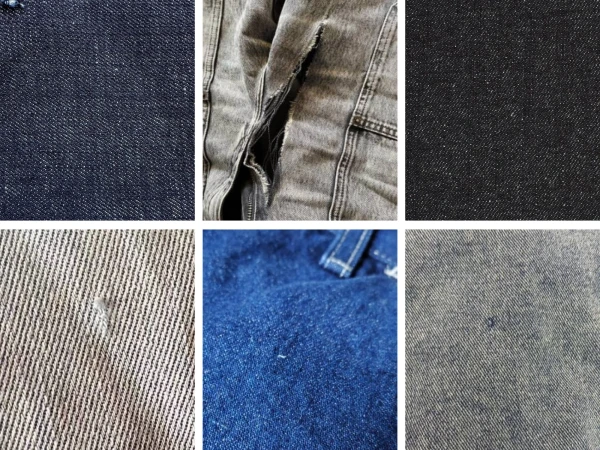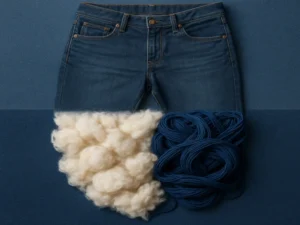In the denim supply chain, fabric inspection is not just a formality—it’s a strategic safeguard. Whether you’re sourcing denim for fashion, workwear, or large-scale manufacturing, undetected fabric defects can lead to production delays, quality complaints, or even costly returns. This guide offers a professional yet accessible checklist of common denim fabric defects, explains their causes and consequences, and shows how to inspect and evaluate fabric before it’s too late.
This article mainly starts from the following points
- Why Denim Inspection Matters
- When and How to Inspect Denim Fabric
- Common Denim Weaving Defects
- Common Dyeing Defects in Denim
- Surface & Structural Defects
- Defects Unique to Stretch Denim
- Fabric Roll Irregularities to Watch
- ZEVA DENIM: Consistency from Weaving to Packing
- Buyer’s Fabric Inspection Checklist
- Conclusion: Build In Quality, Don’t Inspect It Later
1. Why Denim Inspection Matters
Denim is a complex woven fabric, often dyed with indigo and woven with varying tensions and materials (stretch or rigid). This makes it susceptible to multiple defects that can show up during weaving, dyeing, finishing, or storage. For fabric buyers, inspection is the last gatekeeper to ensure only qualified material enters the production process.

Real-World Example:
A mid-sized garment factory reported a 5% rejection rate due to streaky dye lines in denim rolls. After tracing the issue back to uninspected incoming fabric, the brand switched to a supplier offering pre-shipment 4-point inspection, saving thousands in rework costs.
2. When and How to Inspect Denim Fabric
When to Inspect:
– Before shipment (pre-shipment inspection)
– After arrival (warehouse inspection)
– Before cutting (laying inspection)
How to Inspect:
– Use a fabric inspection machine with consistent lighting
– Inspect at a standard speed (15–20 meters/minute)
– Follow a point-based system (e.g., the 4-point system)
– Inspect at least 10% of the total shipment length, or 100% for premium production
3. Common Denim Weaving Defects
a) Broken Pick or Broken End
Description: Missing weft or warp yarn
Cause: Yarn breakage during weaving
Impact: Obvious line or gap in fabric; visible on final garment
b) Double Pick / Double End
Description: Extra yarn inserted unintentionally
Cause: Malfunctioning loom
Impact: Uneven thickness or surface bumps
c) Slubs and Thick Places
Description: Thickened areas of yarn
Cause: Yarn inconsistency or tension issues
Impact: Rough texture or inconsistent appearance
d) Reed Marks
Description: Vertical lines due to uneven spacing in reed
Cause: Defective weaving setup
Impact: Affects fabric smoothness and dye uniformity
4. Common Dyeing Defects in Denim
a) Streaky Dyeing
Description: Uneven indigo absorption, visible as lighter or darker lines
Cause: Inconsistent yarn tension during dyeing or poor oxidation
Impact: Affects appearance consistency, especially in washes
b) Color Variation
Description: Shade difference between rolls or within a roll
Cause: Uneven dip times, chemical concentrations, or oxidation
Impact: Troublesome during garment assembly, especially in bulk production
c) Patchy Dye Spots
Description: Localized dark or light patches
Cause: Contamination in dye bath or poor scouring
Impact: Appears after wash or dry process, often irreparable
5. Surface & Structural Defects
a) Snags and Pulls
Description: Yarn displacement causing loop or bubble
Cause: Rough handling or loom damage
Impact: Weakens structure and impacts visual appeal
b) Bowing and Skewing
Description: Weft yarns are not perpendicular to selvedge
Cause: Improper tension during weaving or finishing
Impact: Pattern alignment issues during cutting
c) Oil Stains or Grease Marks
Description: Dark, slippery stains
Cause: Machine oil contamination
Impact: Rejectable in light washes; difficult to remove
6. Defects Unique to Stretch Denim
a) Bagging or Growth
Description: Fabric doesn’t recover shape after stretching
Cause: Low-quality spandex or improper setting
Impact: Poor fit and consumer dissatisfaction
b) Lively Edge or Curling Selvedge
Description: Edges curl, affecting spreading and cutting
Cause: Yarn twist imbalance or finishing tension issues
Impact: Increases fabric waste during garment cutting
7. Fabric Roll Irregularities to Watch
a) Roll Length Inconsistency
Description: One roll might contain 70m, another 120m
Impact: Planning and cutting inefficiencies
b) Tightly Rolled Edges
Impact: Causes tension lines that lead to permanent creases
c) Roll Identification Errors
Impact: Mismatched batches in production
8. ZEVA DENIM: Consistency from Weaving to Packing
As a professional denim fabric manufacturer in China, ZEVA DENIM offers buyers more than just variety — it provides peace of mind. With over 200 classic and innovative styles, their quality control systems ensure defects are caught long before reaching clients.
ZEVA’s Key Quality Measures:
– 4-Point Fabric Inspection: Each roll is reviewed before packing
– Uniform Roll Lengths: Consistent roll length targets (e.g., 100m per roll)
– Indigo & Sulfur Control: Tight control on dye bath strength and oxidation timing
– Tension Testing for Stretch Denim: To avoid growth or curling
– Rapid Sample Testing: Each batch is swatched and washed for QC
Delivery: Most orders ship in under 7 days
MOQ: Small minimums available
Website: www.zevadenim.com
Whether you’re buying for fashion denim, rigid workwear, or high-performance stretch, ZEVA DENIM ensures quality from yarn to yard.
9. Buyer’s Fabric Inspection Checklist
Use this practical checklist before accepting denim shipments:
10. Conclusion: Build In Quality, Don’t Inspect It Later
Fabric inspection is not just a reactive step—it’s a proactive approach to preventing downstream headaches. The denim industry’s reliance on visual appeal and wash performance makes fabric defects especially costly.
By knowing what to look for, when to inspect, and partnering with reliable manufacturers like ZEVA DENIM, buyers can ensure smooth production, happy customers, and a reputation for quality.
In denim, it’s not just about the look — it’s about the trust built through consistency.





